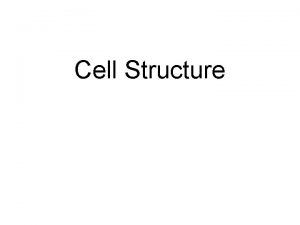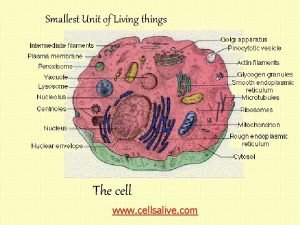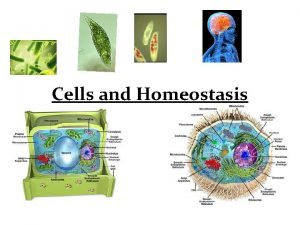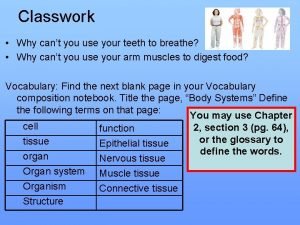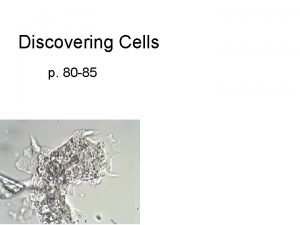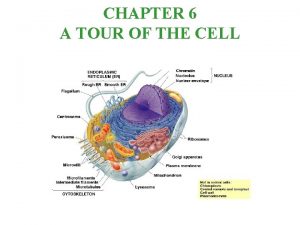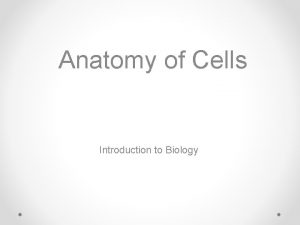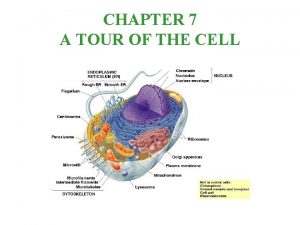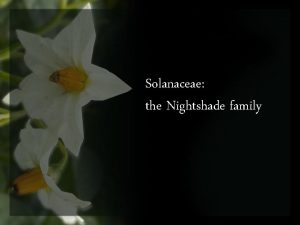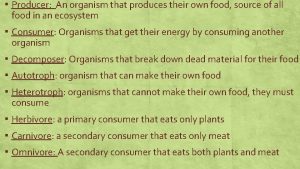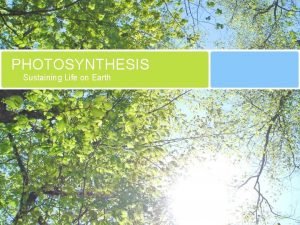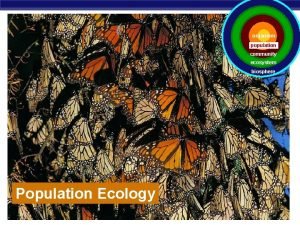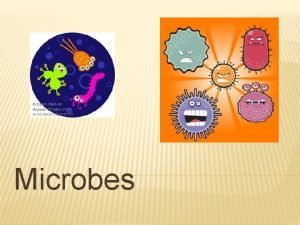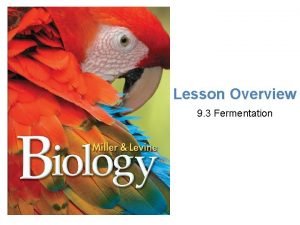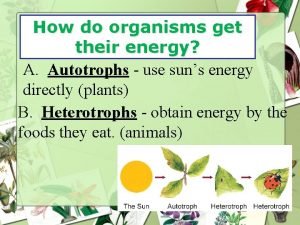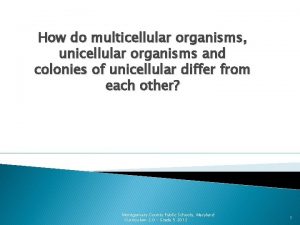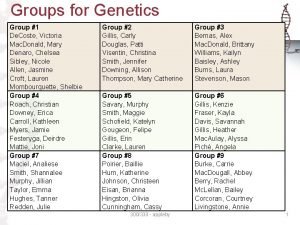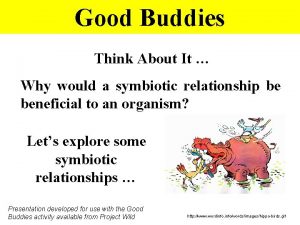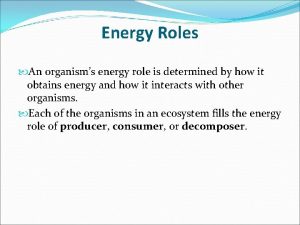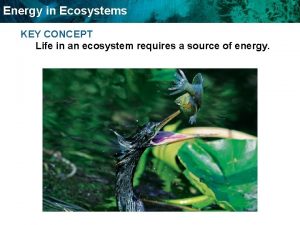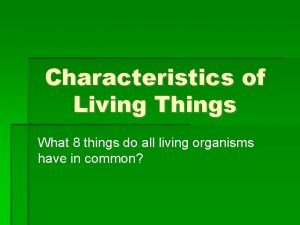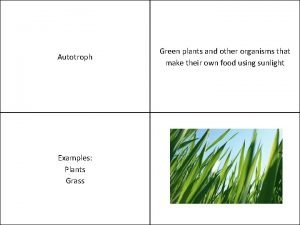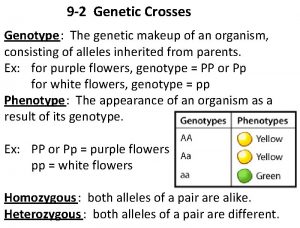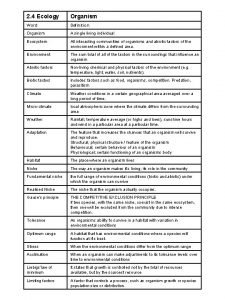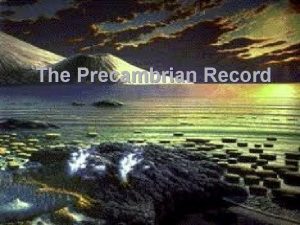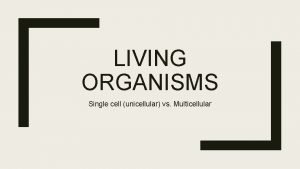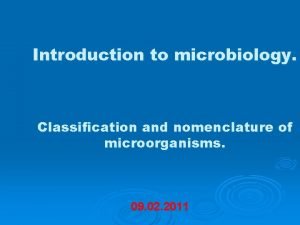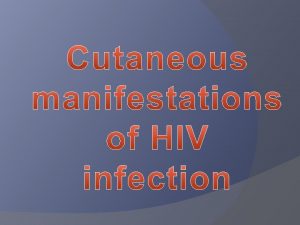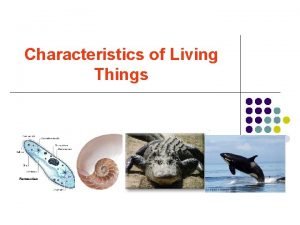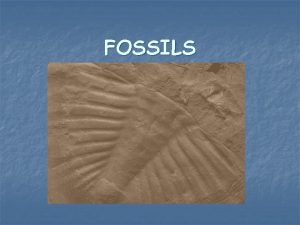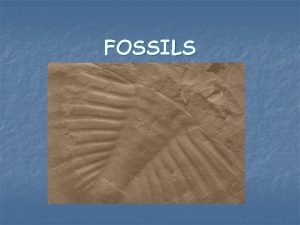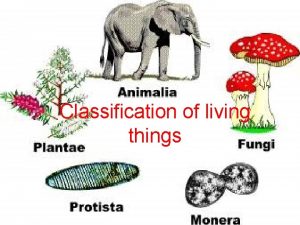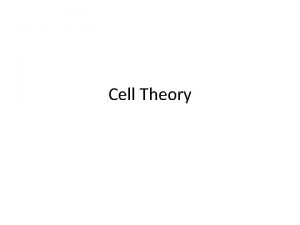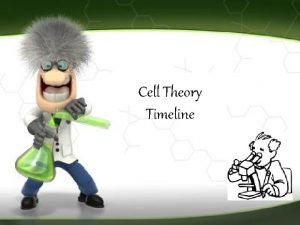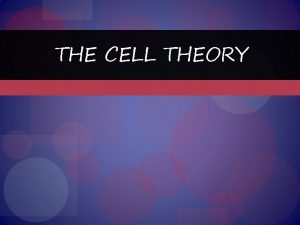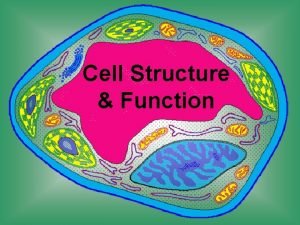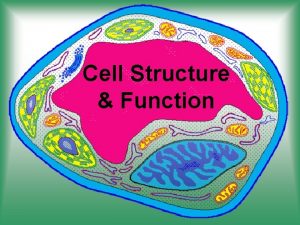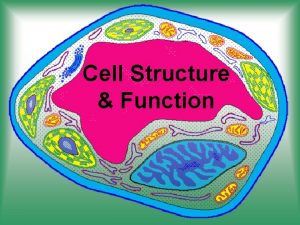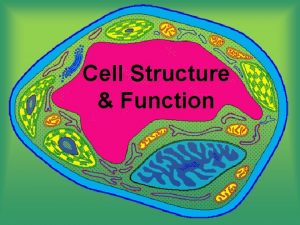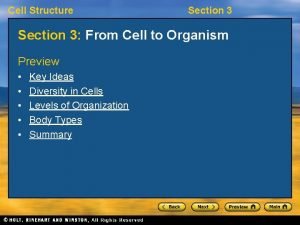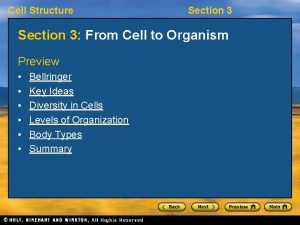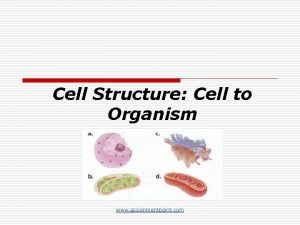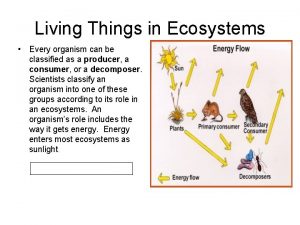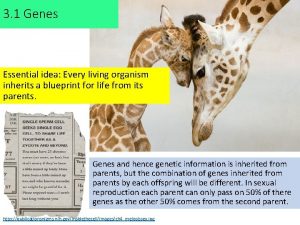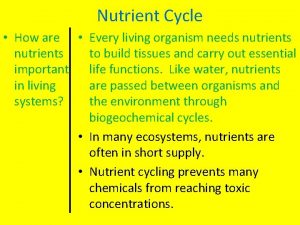Cell Structure Cell Theory Every living organism is

































































- Slides: 65

Cell Structure


Cell Theory • • Every living organism is made up of one or more cells The smallest living organisms are single cells Cells are the functional units of multicellular organisms All cells arise from preexisting cells


Cell Structure • Basic Features of All Cells • Features of Prokaryotic Cells • Features of Eukaryotic Cells

Cells Share Certain Basic Features • • A cell membrane Nucleic acid A cytoplasm Ribosomes

Cell Membrane

Function of Cell Membrane • Isolates the cell’s contents from external environment • Regulates the flow of materials into and out of the cell (i. e. selectively permeable ) • Allows interaction among cells

Structure of the Cell Membrane Fluid-Mosaic Model • Consists of phospholipids and proteins • The head region of each phospholipid molecule “loves” water (i. e. is hydrophilic) • The tail region of each phospholipid “hates” water (i. e. is hydrophobic) • Phospholipids form a bilayer • Proteins are embedded in phospholipid bilayer

Fluid Mosaic Model of the Cell Membrane


Nucleic Acid • Deoxyribonucleic acid (DNA) has two functions: • DNA controls protein synthesis in the cell • DNA is replicated and passed on to progeny cells during reproduction


Cell Cytoplasm • Consists of all materials inside the plasma membrane • It is the “bulk” of the cell • It is the site of cell metabolism: • (1) breaking down complex molecules for energy and simple “building block” molecules • (2) synthesis of new cell structures

Animal Cell

Ribosome • Ribosomes are the sites of protein synthesis, where an RNA strand is translated into an amino acid sequence. • Protein synthesis is extremely important to cells, and so large numbers of ribosomes are found throughout cells (often numbering in the hundreds or thousands).

Ribosomes

Prokaryotes Eukaryotes

Prokaryotic Cells • Lack a nucleus (though DNA is concentrated in a region called the cell’s nucleoid) • Lack membranous organelles • Are small in size ( < 5 um ) • Many have cell walls • Belong to the Domain Archaea and Domain Bacteria


Eukaryotic Cell • DNA is housed in a membranous organelle called the nucleus • Membranous organelles exist in the cytoplasm and perform specific cell functions • A network of protein fibers called the cytoskeleton give the cell shape and stability • Cells are large in size (10 – 100 um)

Animal Cell

Plant Cell

Nucleus • Control center of the eukaryotic cell • Nucleus has three distinct parts: • (1) nuclear envelope: double membrane between nucleoplasm and cytoplasm • (2) nuclear pores: openings between nucleus and cytoplasm • (3) nucleoplasm: fluid portion of nucleus that contains DNA and nucleolus


Nuclear Envelope • Nuclear envelope is a double membrane • Isolates cytoplasm from nucleoplasm • Regulates flow of materials between cytoplasm and nucleoplasm • Outer nuclear membrane is continuous with cytoplasm’s endoplasmic reticulum


Nucleoplasm • Contains the hereditary molecule deoxyribonucleic acid (DNA) which always remains in the nucleus • Loose “non-condensed” strands of DNA are called chromatin (cell is not dividing) • Tight “condensed” strands of DNA are called chromosomes (cell is dividing)


Nucleolus • Present inside of nucleus as a distinct region • Consists of ribosomal RNA, protein, ribosomes and DNA • Nucleoli are the sites of ribosome synthesis in the cell

Nucleus of a Liver Cell


Endoplasmic Reticulum • A complex system of membranes present within the cytoplasm • Endoplasmic reticulum (ER) is continuous with the nuclear envelope and the plasma membrane • ER functions as an internal transport system for the cell


Endoplasmic Reticulum • There are two types of ER: • (1) smooth ER: lacks ribosomes on its surface • Involved in lipid synthesis • (2) rough ER: outside is studded with ribosomes • Involved in protein synthesis


Endo-membrane System

Golgi Complex • A set of specialized membranes derived from the ER • Looks like a stack of flattened sacs or vesicles • Receives contents from ER, modifies these products, and packages them for transport out of cell

Golgi Complex

Lysosome • A membranous sac (or vesicle) containing digestive enzymes • Enzymes used to break down complex molecules in the cell • Lysosomes’ enzymes derived from RER and lysosome’s sac derived from Golgi complex

Lysosome

Vacuole • Membranous sac used for storage of water, waste, nutrients in the cell • Plant cells tend to have one, large vacuole • Animal cells tend to have numerous, small vacuoles

Plant Cell Vacuole

Peroxisome • Similar to lysosome • Membrane-bound vesicle that contains enzymes • Enzymes are used to breakdown toxic substances to hydrogen peroxide • Hydrogen peroxide is broken down by catalase to produce water and oxygen


Mitochondrion • Double membrane organelle • Outer membrane is smooth • Inner membrane is highly folded (in order to increase inner surface area for cellular respiration) • Folds are called cristae (sing. crista) • Inner fluid portion of mitochondrion is called the matrix

Mitochondrion Structure

Mitochondrion • Space between inner and outer membrane is called the intermembrane compartment • Function of mitochondrion is the breakdown of complex molecules to release energy for the cell (cellular respiration) • All eukaryotic cells have mitochondrion

Muscle Cell Mitochondrion

Chloroplast • Present only in plants • Site of photosynthesis • Double membrane system encloses the fluid-filled space called the stroma • Membrane system within stroma is organized into interconnected, flattened sacs called thylakoids



Cytoskeleton • A network of protein fibers in the cell cytoplasm • Keeps organelles in place in cytoplasm and allows movement of organelles • Provides rigidity and structure to cell • Assists in cell reproduction (centrioles)

Cytoskeleton of Nerve Cell

Cytoskeleton Components • Actin filaments, a. k. a. microfilaments • Microtubules • Intermediate Filaments

Actin Filaments • Long, extremely thin fibers that occur in bundles or mesh-like networks • Structural role in cytoplasm, just beneath plasma membrane • Interact with protein molecules to allow movement of cell and its organelles


Microtubules • Larger than microfilaments • Microtubule production under the control of an organizing center called the centrosome • Centrioles, which are composed of microtubules, are also involved in microtubule assembly • Microtubules involved in maintaining shape of cell and movement of cell and its organelles • Cilia and flagella are produced from microtubules by the centrioles


Centrioles

Cilia: 9 + 2 Arrangment

Flagella and Cilia

Intermediate Filaments • Size between microfilaments and microtubules • Provide support to nuclear and plasma membranes


Evolution of Eukaryotic Cells • Endosymbiotic Hypothesis • 1) larger “host” prokaryotes formed a symbiotic relationship with smaller prokaryotes eukaryote and it’s organelles • 2) eg. aerobic heterotrophic bacteria mitochondrion • 3) eg. cyanobacteria chloroplast
 Why does organism eat another organism
Why does organism eat another organism Living organism
Living organism Smallest unit of life
Smallest unit of life Living organism
Living organism Smallest living unit in the body
Smallest living unit in the body Every nation and every country has
Every nation and every country has Microsoft empower every person
Microsoft empower every person Every knee shall bow every tongue confess
Every knee shall bow every tongue confess Every rotarian every year
Every rotarian every year Every nation and every country
Every nation and every country Every picture has a story and every story has a moment
Every picture has a story and every story has a moment Every child every day
Every child every day Every living plants and animals must have
Every living plants and animals must have Difference between living and non living organisms
Difference between living and non living organisms Is a seed living or nonliving
Is a seed living or nonliving Living non living dead
Living non living dead Smallest living unit of life
Smallest living unit of life What does unicellular
What does unicellular Cell tissue organ organ system organism
Cell tissue organ organ system organism Cells group together to form
Cells group together to form Organism that is made up of only one cell
Organism that is made up of only one cell Alterations in the structure of an organism
Alterations in the structure of an organism The scientist mathias schleiden studied _______ in ______.
The scientist mathias schleiden studied _______ in ______. A cell is a living unit greater than the sum of its parts
A cell is a living unit greater than the sum of its parts Capsule flagella pili nucleoid desmosome
Capsule flagella pili nucleoid desmosome The cell is a living unit greater than the sum of its parts
The cell is a living unit greater than the sum of its parts Nonliving particle that replicates inside a living cell
Nonliving particle that replicates inside a living cell Brown and clough theory on group living summary
Brown and clough theory on group living summary Living educational theory
Living educational theory Living educational theory
Living educational theory Organism
Organism Multicellular definition
Multicellular definition Nicholas seeliger, md flpen panama city beach fl
Nicholas seeliger, md flpen panama city beach fl Transgenic organism
Transgenic organism Solanaceae kingdom
Solanaceae kingdom Organism producer
Organism producer Diatom kingdom
Diatom kingdom Animal kingdom phylogenetic tree
Animal kingdom phylogenetic tree What is a photosynthetic organism
What is a photosynthetic organism Exponential growth formula bio
Exponential growth formula bio Microscopic organism definition
Microscopic organism definition Where does fermentation occur
Where does fermentation occur Draft horse organism classifications
Draft horse organism classifications Which organism is an autotroph
Which organism is an autotroph Multicellular organism
Multicellular organism The area where an organism lives is its
The area where an organism lives is its Wesley homeshare
Wesley homeshare Best buddies jobs
Best buddies jobs Anything that surrounds us is known as
Anything that surrounds us is known as What are energy roles
What are energy roles A consumer that primarily eats one specific organism
A consumer that primarily eats one specific organism How do organism grow
How do organism grow Organism order
Organism order Is a grass an autotroph or heterotroph
Is a grass an autotroph or heterotroph Genetic crosses section 9-2 review
Genetic crosses section 9-2 review Organism ecology definition
Organism ecology definition A consumer that primarily eats one specific organism
A consumer that primarily eats one specific organism Unicellular and multicellular organisms
Unicellular and multicellular organisms Precambrian organisms
Precambrian organisms Caribbean cleaners national geographic
Caribbean cleaners national geographic Whats an organism's niche
Whats an organism's niche What is cells
What is cells Kingdom of microorganisms
Kingdom of microorganisms Causative organism of hiv/aids
Causative organism of hiv/aids Organism examples
Organism examples Organism
Organism

